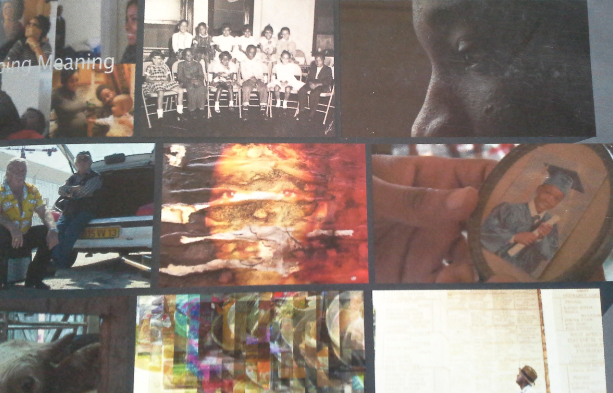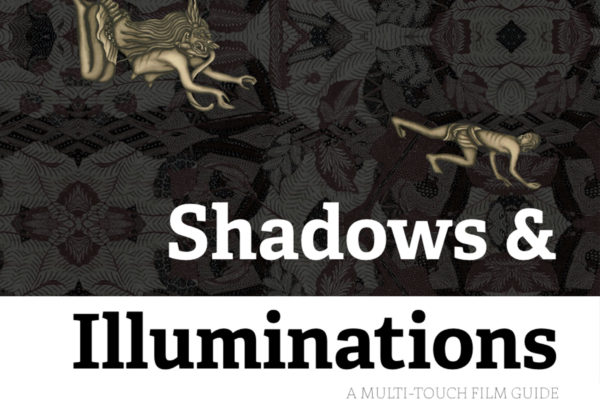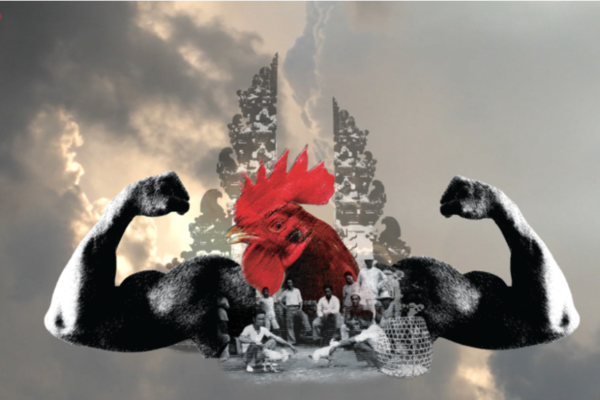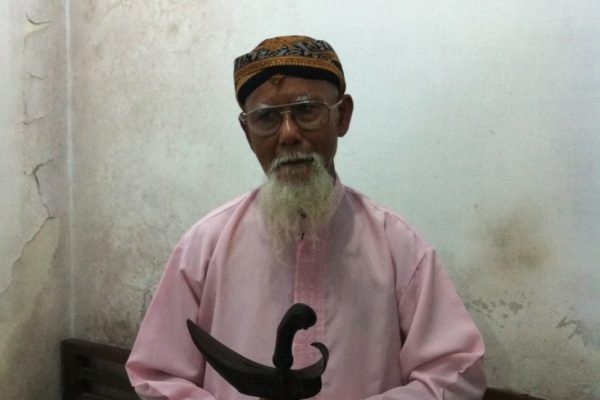Earlier this month I braved the lingering polar vortex to head out to the second annual Screening Scholarship Media Festival at the University of Pennsylvania in Philadelphia, organized by Camra, the university’s “interdisciplinary collective of researchers and educators committed to participatory, experimental media-making.” As one of the first groups I have heard to use the word “multi-modal” ethnography to describe and encompass the new multi-media and multi-sensory approaches being used in contemporary anthropology (outside of our office here at Elemental), I wanted to learn more about the group and see what kinds of new work they were showcasing by attending their day-long festival held at the Annenberg School for Communication.
As articulated by Sofia Chapparro, the festival’s director, in her opening speech, the event was designed to create new spaces for exploring multi-modal ethnography and asking key questions about the evolving genre, particularly: How can we tell our stories differently through images and sound? How do multimodal ethnographic methods change the methodologies—or even the idea—of research?
The festival strove to provide some answers to these questions via traditional methods of panel presentations, film screenings, and group discussions, but it also wove interactive media into its format, featuring a live twitter feed of the conference, interactive installations in the main hall to be explored during breaks, discussion and Q & A sessions using Google hangout, and emailed-in commentary from presenters who were unable to attend in person. The result was a tech-forward, multi-format, community-inclusive, and vibrant exchange of ideas. As with any such event, I was only able to take in some of what the festival had to offer, but here is my report and my two cents, in the hopes that this post might introduce those who weren’t able to attend the conference to some of the ethnographers and media artists featured and contribute to the ongoing process of thinking through the practice and implications of multi-modal ethnography.
Panel 1: Incorporating Digital Cinema Technology into Anthropological Research: Films from the Advanced Lab for Visual Anthropology
This panel presented two films that came out of the Advanced Lab for Visual Anthropology at Cal State Chico in Northern California. Both were visually gorgeous, perhaps in part due to the lab’s state of the art cameras and editing facilities.
Treading Water by Jesse Dizard presented the issue of water scarcity and water rights in Northern California. Created mostly from landscape shots and interviews with local farmers, fishermen, environmental activists, resource managers, and politicians, this film was clearly based on ethnographic methods and the concepts and concerns of ecological and environmental anthropology; investigating human adaptations and relationships with their biophysical environments, the management of natural resources, and the political ecologies informed by local cultural practices and power struggles. Dizard adapted this for a familiar documentary format: a first act presented the problem of water scarcity in Northern California; a second-act shockingly revealed that it is not simply overpopulation or large-scale environmental changes leading to water shortages but mismanagement by corporate farms, fracking operations, and absentee water rights owners; and a third act resolved the film with a positive message of potential renewal and an urgent call to action. This was ethnography mixed with savvy activist documentary rhetoric.
Bound to Tradition by Anna Rushton was introduced as being about the native practice of building cradleboards for newborns, but through its focus on traditional weaving practices—which requires access to pesticide-free sapling forests—also veered into similar conceptual territory of land rights and resource management.
Dizard is a professor and Rushton is a student, and while Dizard’s narrative structure was much tighter than Rushton’s, both films looked crisp, smooth, and with nicely composed shots. While neither filmmakers were present in person to discuss the role that visual anthropology per se plays in their work, I felt the high quality of their images lent an air of professionalism and legitimacy that might be important to the ever-emphasized cross-over potential of visual anthropology. To put it succinctly: maybe visual anthropologists who want to be relevant outside academia should strive to make films that look like professionally produced film and television.
Panel 2: The State of Visual Anthropology. A screening and discussion of John Bishop’s film In The Wilderness of A Troubled Genre.
This film is still new, having only screened at two festivals before SSMF 2014. It is a real treasure for anyone interested in ethnographic film, as it is almost completely comprised of interviews with many of the most significant ethnographic filmmakers and thinkers in visual anthropology including Robert Gardner, Jay Ruby, John Marshall, Paul Henley, David McDougall, and many more. Bishop’s extensive experience in the field and long-time collaborations and friendships with the people interviewed—often in the hallways of AAA conference hotels—gave the film a palpable warmth and the film was chock full of prescient opinions, personal anecdotes, and quotable sound bytes. For example, Gardner when asked the age-old question of what makes film an ethnographic or anthropological film: “How could anything as pretentious as anthropology ever be defined? It’s trying to understand everything all the time.” John Marshall when asked advice about how to make a good ethnographic film: “Ethnography is an abstraction, a relationship is an abstraction. You can’t take a picture of that. What you’re always doing, whether you know it or not, is taking a picture of a person.”
After the screening there was a lively discussion with John Bishop, the filmmaker and founder of Media Generation; Brent Luvaas, professor of Anthropology at Drexel University, the co-editor of Visual Anthropology Review and author of the street style blog Urban Field Notes; and John L. Jackson, Jr., a professor of Anthropology, Communications, and Africana Studies at U Penn and producer and co-director of Bad Friday among other films.
The wide-ranging discussion focused on the storied past, ambivalent present, and promising future of visual anthropology and ethnographic film. According to Luvaas, ethnographic film specifically and visual anthropology more broadly seem to be awkwardly positioned somewhere between being almost-entirely dispensable—as he put it, “space filler” that profs include in the syllabus to kill time right before exams—and the very future of the field, best-situated to bridge the gap between the academy and the lay person, especially now as more and more anthropology journals prepare to go completely digital. If in the coming years text will be, again in Luvaas’s words “taking a back seat” as audio-visual data presentation becomes the “new normal,” then how can the field make sense of its history and transform itself for this ever nearer future?
Jackson continued the conversation by reflecting on the heritage of ethnographic film, and posing young ethnographic filmmakers a number of provocative questions in moving forward. For example, is the heritage of ethnographic film “a prison or a perch”? In seizing the new multi-modal digital moment, how much of the old styles and strategies of ethnographic filmmaking should we keep? Similarly, how can the field establish ways of working with mainstream film, aligning or decisively not aligning with its traditions? Does ethnographic film have a responsibility to be “entertaining” the way mainstream film does? In the end, Jackson seemed to call upon emerging ethnographic filmmakers to “de-center the familiarity of the image” and move beyond both pre-existing film conventions to make something new.
Bishop contributed pithy anecdotes based on his experiences in the field, sidestepping the more jargon-y or academic aspects of debates to ground them in real-life situations. Ultimately, all agreed that whatever other characteristics might determine a particularly “ethnographic” film perhaps the defining parameter is to be ethical and responsible to its subjects and their lives.
In this panel, and throughout the conference, a recurring point was that visual ethnography is additive. Seemingly, no one considers it a substitution for written ethnography, and people who don’t do written ethnography in addition to their visual work, like John Bishop himself, are not calling themselves anthropologists.
Lunch Break: Interactive Installations
The brief break in the proceedings provided the opportunity to explore the various installations on display. These installations did indeed strive to “de-center the familiarity of the image” thus fulfilling a part of Jackson’s idea of the ethnographic. The brochure connected the works to the ethnographic project by explaining that they were made “in order to provide new insights into routine acts, particularly routine acts of media consumption and interaction with various technologies.” Joan Oh’s short film 4GB represented virtual storage space as the physical space of blown up balloons. Charlotte Webb’s Flickr Nude or Noodle Descending a Staircase created a “staircase” of images generated by a keyword search. Christopher Vandegrift offered a work he entitled Recursive Dictation: “Cumulative Error”, which was a video screen capture of ongoing translation of a phrase put through the Mac OS-X’s Dictation software (speech to text) to it’s Speech Synthesis Engine (text to speech) and back again. The result was sort of like an unending game of telephone where the phrase “cumulative error” turned into “it on to her” to “your hair turn” to “You weren’t he’ll learn” and so on.
These were all fun, and the explanations their creators provided during a virtual panel presentation used a lot of complicated ideas about media consumption and subjectivity, but to me they didn’t necessarily provide a new perspective on our interaction with media and technology and seemed the furthest afield from ethnographic practice. The most notable, and most notably ethnographic, installation was When They Give Their Word, Their Word is Bond, a project by Maryam Kashani (which has also screened at Ethnographic Terminalia) based on her research with Bay Area Muslim communities. Kashani’s video is a split screen-loop: the left half of the screen captures Imam Zaid Shakir giving a sermon inside “The Lighthouse,” his Oakland mosque, while the right half shows him discussing one of his favorite Quranic verses in a lush garden.
This piece was powerful to me in the way it drew attention to Imam Shakir’s patterns of speech and the rhythmic power of oratory; the juxtaposition of the two videos made it difficult to follow a line of argument or the specific verbal content of each talk, yet the aural bath of alternately quietly prayerful and exhortative and celebratory sound combined with the backdrop of two sacred spaces—the white wall of the mosque, the lush red and green leaves in the garden—created a mood of divinity, majesty, and mystery. After hearing the one phrase that jumped out at me, “Don’t believe the hype: you are special, you are unique, you are distinct!” I was left with a feeling of enhanced possibility and excitement that emerged from a buzz of sensory stimulation; perhaps in this way the film put me in a position similar to that of a believer, recreating an aspect of the experience of spiritual inspiration. Exploration of Maryam’s website shows she has some other interesting projects under her belt and I think she is an emerging ethnographic filmmaker to watch.
Panel 3: Community Media-Making, Activism, and the Academy: Models of Multimedia Collaboration between Scholars, Artists and Community Groups
The conference seemed admirably committed to showcasing some of the educational and outreach work being done by UPenn anthropology students and professors. There were numerous panels focused on work being done in Philadelphia around pressing issues of school budget cuts, incarceration, and more. While I couldn’t attend all of these and other panels, I was very impressed by what I saw and heard at this session with participants in Scribe.
Scribe is a video center where people can learn the tools of audiovisual media production in a supportive and collaborative environment through workshops, master class, summer camps, and more. Classes are taught by experienced media makers while ethnographers, oral historians, graduate students, and other academics work as partners to teach their skills and methods so that community members can apply these skills in projects that are important to them.
A panel of Scribe participants discussed two such projects, Precious Places Community History Project and Muslim Voices of Philadelphia, and presented a pair of informative and moving shorts from these that educated viewers about the importance of local places and communities in the words of residents and participants, including the La Mott Public Garden, a historic garden threatened by development projects, and one of the first masjids, or mosques, in Philadelphia.
I was impressed with the mastery of foundational ethnographic methods of participant observation, observation and interviewing and the production skills in camera work, sound recording, and editing evident in these films. This panel reminded me that engaging with the “politics of representation” doesn’t mean having to engage with complicated academic theory: rather, it can be something as simple as ensuring that underserved and under- or misrepresented groups get their voices heard and their emic perspectives included in mainstream media formats. As one filmmaker on the panel put it, “knowing how to be articulate with film and video is a basic form of literacy today,” and increasing access and familiarity with this new literacy can and should be better disseminated both within and outside the academy.
Panel 4: Media, Scholarship, and Social Change
This final panel and marquee event featured presentations from and discussions amongst three panelists who were using visual methods in very different ways to complement their ethnographic scholarship.
Roxanne Varzi, an associate professor at UC Irvine, discussed her film Plastic Flowers Never Die about the Iran-Iraq war and post-Revolution public culture in Iran. She put this in relationship to her installation booth that was on view during the conference, called “The whole world blind,” which invites participants to enter a booth, blindfold themselves, and listen to visual descriptions of war photography. In her talk, Varzi addressed her increasingly autobiographical and subjective engagement with images of the war, co-opted as government propaganda, after over a decade of work in the region. Her descriptions of her personal relationship to the ethnographic material as a Persian who left Iran, was quite interesting, but I found her installation theory-heavy yet unsuccessful, particularly in her problematic metaphoric deployment of disability, e.g. “the dead are like the blind,” and her descriptions of photographs which were more philosophical than functionally interpretive.
Peter Lucas, a photographer and professor at NYU and the New School concerned with human rights education, peace studies, and participatory media, presented two visual projects of his: Viva Favela, an e-book ethnography about citizen journalism incorporating the work of favela photographers themselves, and The Mural of Pain, a haunting short film devised as a mourning poem honoring those killed by gun violence in Brazil. This last work was breathtakingly beautiful and simple in it’s conception: aging and damaged photographs of the dead accompanied by a poetic text and a soundtrack taken from a live memorial event where these photographs were presented, the loved ones in them remembered, and the tragedy of small arms violence addressed. While memorable for its poetry and striking visuals, the access to this audio footage and visual archive was made possible by Lucas’s long-term participant observation in favela communities.
The third speaker was Tufuku Zuberi, who talked about applying what he learned through participation in mainstream media as a “detective” on PBS’s History Detectives to create a historical film about African Independence. This project took yet another approach to visual presentation of ethnographic research, applying an old-school public television style of direct address to the viewer, and purposefully forefronting the process and praxis of education.
Click here to read Part 2.






